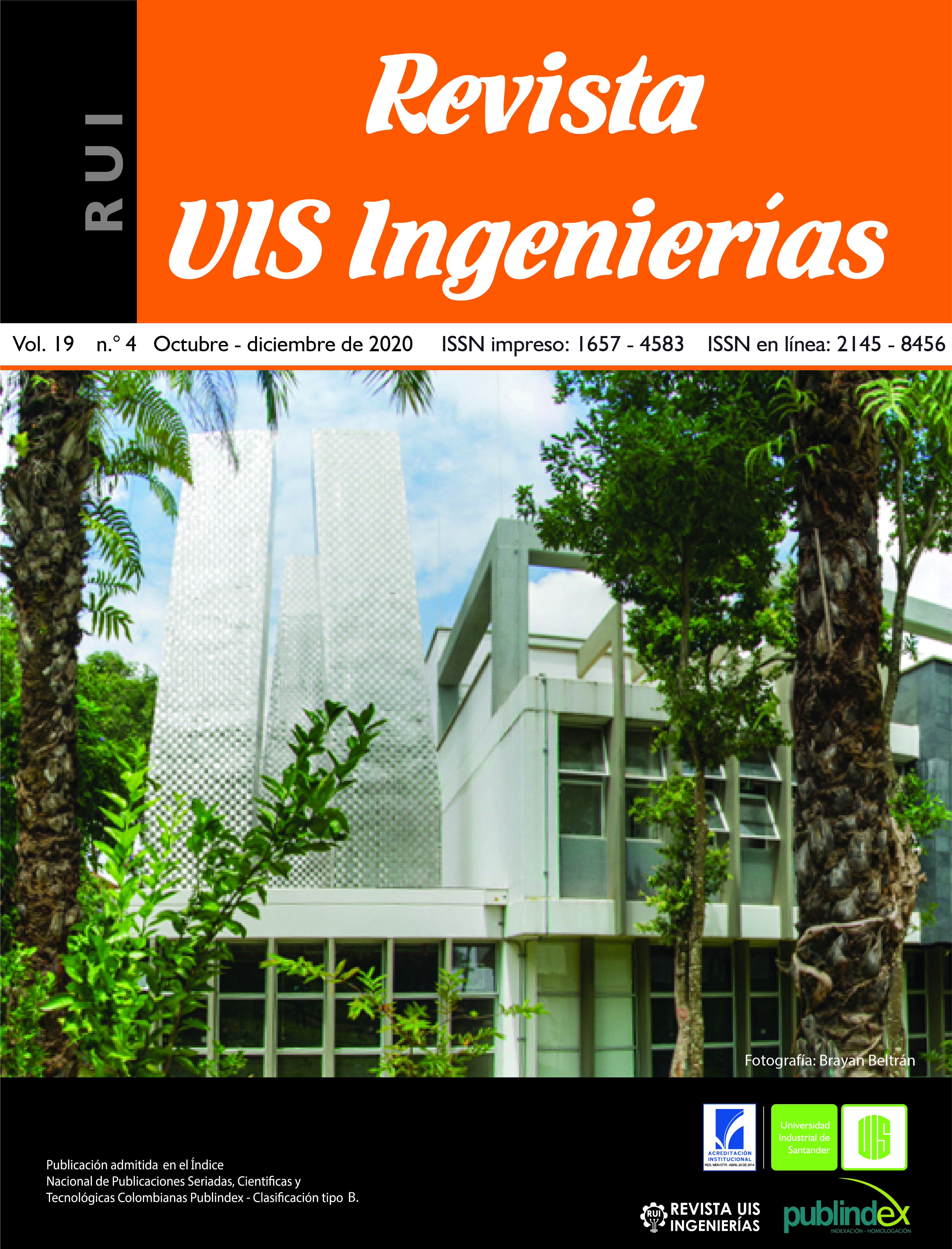Evaluation of the formation of andradite and carbonates of calcium in the synthesis of a geopolymer from white slag
Published 2020-06-30
Keywords
- geopolymers,
- white slag,
- sodium hydroxide,
- carbonatation
How to Cite
Copyright (c) 2020 Revista UIS Ingenierías

This work is licensed under a Creative Commons Attribution-NoDerivatives 4.0 International License.
Abstract
In this article, the influence of the andradite on the mechanical resistance synthesized from the furnace slag converter is evaluated. As activators, 12 M sodium hydroxide and 5 M sodium silicate were used. Sodium hydroxide remained constant at 5% and at 15% in sodium silicate. Ceramic material was added in proportions of 5%, 10%, 15% and 20%. The curing of the paste was done at room temperature for 24 hours. The particle size of the white slag and the ceramic material was 150 μm. XDR and MEB were used to analyze the possible mechanisms of formation of andradite and calcium carbonate. Samples were failed in the universal testing machine. The influence of the chemical compounds formed on the compressive strength was determined. The results indicate that the proposed conditions are suitable for the formation of crystalline structures characteristic of geopolymeric materials.
Downloads
References
[2] G. Gayathri, V. S. Ramya, T. Yasotha, M. Dheenedhayalan, “Experimental investigation on geopolymer concrete with E-waste”, International Journal of Research and Reviews in Applied Sciences and Engineering, vol. 8, no. 2, 2016.
[3] A. Hajimohammadi, T. Ngo, J. Vongsvivut, “Interfacial chemistry of a fly ash geopolymer and aggregates”, Journal of Cleaner Production, vol. 231, pp. 980-989, 2019, doi: 10.1016/j.jclepro.2019.05.249
[4] M. Ahdaya, A. Imqam, “Fly ash Class C based geopolymer for oil well cementing”, Journal of Petroleum Science and Engineering, vol. 179, pp. 750-757, 2019, doi: 10.1016/j.petrol.2019.04.106
[5] Y. Wang, J. Zhao, “Facile preparation of slag or fly ash geopolymer composite coatings with flame resistance”, Construction and Building Materials, vol. 203, pp. 655-661, 2019, doi: 10.1016/j.conbuildmat.2019.01.097
[6] P. Sarker, S. Mcbeath, “Fire endurance of steel reinforced fly ash geopolymer concrete elements”, Construction and Building Materials, vol 90, pp 91-98, 2015, doi: 10.1016/j.conbuildmat.2015.04.054
[7] M. Marcin, M. Sisol, I. Brezani, “Effect of Slag Addition on Mechanical Properties of Fly ash Based Geopolymers”, Procedia Engineering, vol. 151, pp. 191-197, 2016.
[8] F. Skvara, “Alkali activated materials or geopolymers”, Ceramics – Silikáty (2007) pp 173–177.
[9] M. Lahoti, K. Tan, E Yang, “A critical review of geopolymer properties for structural fire-resistance applications”, Construction and Building Materials, vol 221, pp 514-526, 2019, doi: 10.1016/j.conbuildmat.2019.06.076
[10] P. Sarker, S. Mcbeath, “Fire endurance of steel reinforced fly ash geopolymer concrete elements”, Construction and Building Materials, vol. 90, pp 91-98, 2015, doi: 10.1016/j.conbuildmat.2015.04.054
[11] G. Kürklü, “The effect of high temperature on the design of blast furnace slag and coarse fly ash-based geopolymer mortar”, Composites Part B: Engineering, Vol. 92, pp. 9-18, 2016.
[12] A. Villaquirán-Caicedo, D. Rodríguez, R. Mejía, “Evaluación microestructural de geopolímeros basados en metacaolín y fuentes alternativas de sílice expuestos a temperaturas altas”, Ingeniería, Investigación y Tecnología. vol. 16, pp. 113-122, 2015.
[13] M Ha , G. Le-Saout, F. Winnefeld, B. Lothenbach, “Influence of Activator Type on Hydration Kinetics, Hydrate Assemblage and Microstructural Development of Alkali Activated BlastFurnace Slags”, Cem. Concr. Res., vol 43, no 3, pp. 301-310, 2011.
[14] L. Xing, R. Feng, S. Shaoxian, A. Corona, N. Ortiz, E. Aguilar, “Effects of aggregates on the mechanical properties and microstructure of geothermal metakaolin-based geopolymers”, Results in Physics, vol 11, pp 267-273, 2018.
[15] L. Xing, R. Feng, S. Shaoxian, M. Qinyong, “Deterioration in the microstructure of metakaolin-based geopolymers in marine environment”, Journal of Materials Research and Technology, vol 8, no 3, pp 2747-2752, 2019.
[16] T. Saeki, P. Monteiro, “A model to predict the amount of calcium hydroxide in concrete containing mineral admixture”, Cement and Concrete Research, vol. 35, no. 10, pp. 1914– 1921, 2005.
[17] O. Gutiérrez, Y. Pineda, E. Vera, “Resistencia a la Carbonatación de Concretos elaborados con Ceniza Volante, Escoria de Alto Horno y Cemento Comercial”, Revista Interciencia, vol. 51, no. 4, 2015, doi: 10.3989/revmetalm.058
[18] B. Dong , Q. Qiu, J. Xiang, C. Huang, H. Sun, F. Xing, Y Liu. “Electrochemical impedance interpretation of the carbonation behavior for fly ash–slag– cement materials”, Construction and Building Materials, vol. 93, pp. 933-942, 2015.
[19] Asociación Española De Normalización Y Certificación. Productos y sistemas para la protección y reparación de estructuras de hormigón. Métodos de ensayo. Determinación de la resistencia a la carbonatación. UNE-EN 13295. Madrid: AENOR, vol. 18, 2015. Disponible en: http://www.anfapa.com/downloads/54_monografico-reparacion.pdf
[20] Réunion Internationale Des Laboratoires Et Experts Des Matériaux, Systèmes De Construction Et Ouvrages - RILEM, CPC-18 Measurement of Hardened Concrete Carbonation Depth, Materials and Structures, vol. 21, no. 6, pp 453-455, 1988. Disponible en: https://www.rilem.net/gene/main.php?base=500221&id_publication=4&id_papier=3965
[21] H. Cui, W. Tang, W. Liu, Z. Dong, Y. Xing, “Experimental study on effects of CO2 concentrations on concrete carbonation and diffusion mechanisms”, Construction and Building Materials, vol. 93, pp. 522-527, 2015.
[22] American Concrete Institute, Protection of Metals in Concrete Against Corrosion. Informe técnico ACI 222.R-01 (Reapproved 2010). Farmington Hills, MI: ACI, pp.41. 2011. Disponible en: https://www.concrete.org/store/productdetail.aspx?ItemID=22201&Format=DOWNLOAD&Language=English
[23] G. Sedmale, M. Randers, M. Rundans, V Seglins, “Application of differently treated illite and illite clay samples for the development of ceramics”, Applied Clay Science, vol. 146, pp. 397-403, 2017.
[24] P. Monich, A. Romero, D. Höllen, E. Bernardo, “Porous glass-ceramics from alkali activation and sinter-crystallization of mixtures of waste glass and residues from plasma processing of municipal solid waste”, Journal of Cleaner Production, vol. 188, pp. 871-878, 2018.
[25] J. Davitovits, “Global warming impact on the cement and aggregates industries”, Geopolymer Institute, vol. 6, no. 2, pp. 263-278, 1994.
[26] J. Davitovits, M. Davitovits, “Geopolymer: room-temperature ceramic matrix for composites”, Ceramics Engineering Science Process, vol. 9, no. 7, pp. 835-842, 1998, doi: 10.1002/9780470310496.ch34

